
Recipe: Just a bite's worth and easy to make
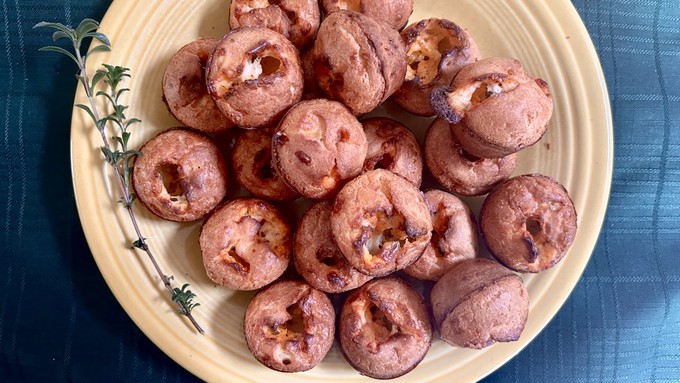
These little popovers will go fast at any gathering. They feature three cheeses and winter savory, but can be customized for any tastes. Kathy Morrison
Ever made popovers? The ingredients are so ordinary, but the results are fantastic: Puffy, doughy and crunchy all at once. They can be savory or sweet -- delicious alongside soup or chili this time of year, or split open for a slathering of jam.
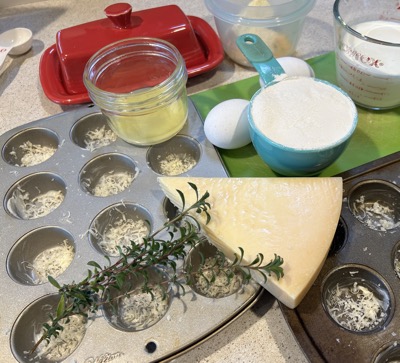
I typically use a standard 12-cup muffin pan, though I do own a classic popover pan, which makes six high-hat popovers at a time. But I got to thinking: How about making popovers in a mini muffin pan? That would produce at least two dozen, which could be served at a potluck or game day gathering.
I settled on a combination of cheeses for the flavoring, along with a lesser known but excellent herb: Winter savory. This plant is an easy-care perennial that resembles thyme but is sturdier. Mine gets an occasional shearing, but otherwise it's happy to be left alone in its planter. The flavor is stronger than thyme, so it's an excellent accent to many cheeses and to winter favorites such as stew.
The cups on my mini muffin pans are just about 1 inch deep. If you don't have that size pan available, this recipe will work in the standard muffin pan; adjusted baking times are included below. I mix my batter in a blender, but this works just fine blended with a hand mixer or a whisk.
Note: Be sure to grease the pans with butter or oil, and dust the cups with flour, grated cheese (as done here) or sugar -- popovers are notorious for sticking, even in nonstick pans.
Herb and cheese popover bites
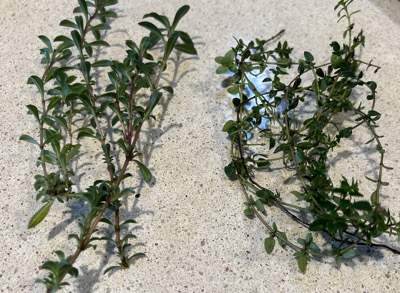
Makes 24-plus bites or 12 standard muffin-size popovers
Ingredients:
1 tablespoon unsalted butter, melted, plus more butter for the pans (or use a neutral cooking oil on the pans if you prefer)
2 tablespoons Parmesan cheese for pans (optional, but use some flour if not using cheese)
1 cup milk (dairy or non-dairy, any kind except nonfat), room temperature
1 cup all-purpose flour
Pinch of salt
Pinch of freshly ground pepper
Pinch of cayenne pepper (optional)
2 large eggs, room temperature, lightly beaten
For filling:
1 tablespoon brick-style cream cheese (not the whipped or tub kind), softened
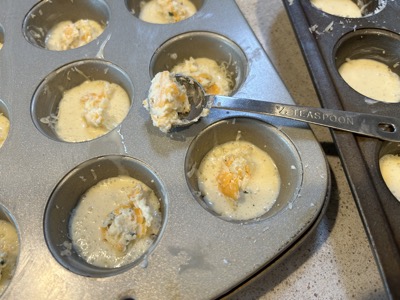
3 tablespoons grated Cheddar cheese
3 tablespoons grated Parmesan cheese
1/2 to 1 teaspoon fresh winter savory or thyme leaves, chopped
Instructions:
Preheat oven to 450 degrees F. Grease the cups of two mini muffin pans (24 cups total) with butter or oil and sprinkle about 1/4 teaspoon grated Parmesan in the bottom of each one.
Blend together the milk and the melted butter. Whisk the flour and the seasonings together, and add slowly to the milk mixture. (Using the blender, I add about a third of the dry ingredients at a time, scraping down the blender after adding each third.)
Then add the eggs and blend thoroughly but don't whip the mixture.
Let the batter rest while mixing the filling: In a small bowl, mash together the cream cheese, Cheddar cheese and 3 tablespoons grated Parmesan until blended. Stir in the chopped herbs.
Pour just enough batter into the muffin cups to cover the bottoms. Add a generous 1/4 teaspoon of the cheese mixture to each cup, then top with batter almost to the top edge of the cup. (Any extra batter can be baked in a greased custard cup, ramekin or other small baking dish.)
Place the pans on a middle rack in the oven and bake for 10 minutes. (Avoid opening the oven while it's at 450 degrees until the 10 minutes are up: This is crucial for the popovers to rise.) Lower the temperature to 350 degrees and continue baking 7-9 minutes until popovers are brown and crisp (for this you can check).
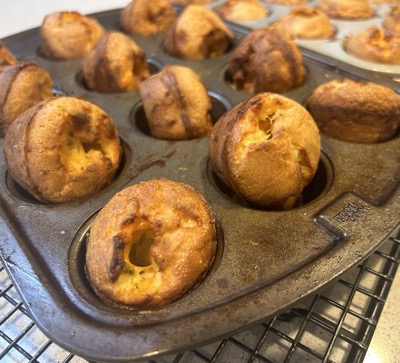
Remove to cooling rack. Run a blunt knife or small spatula around the edges of the cups and tip the popovers up to release any steam. Serve soon, warm or room temperature. They can be reheated by wrapping in foil and placing in a 350 oven for a few minutes.
To bake in a standard muffin pan: Bake at 450 degrees for 15 minutes, then 15 to 20 minutes at 350 degrees. Proceed as above.
Sweet herb variation: Dust the cups with granulated sugar instead of Parmesan. Don't use black pepper or cayenne in the flour. For the filling, combine 3 tablespoons softened cream cheese with a pinch of salt, a pinch of sugar, 1 teaspoon lemon or lime zest and 1 teaspoon chopped fresh thyme or lemon verbena. Bake as above.
Related Articles
Beat the winter blahs with cool-season aahs!
Comments
0 comments have been posted.Sacramento Digs Gardening to your inbox.
Sites We Like
Garden Checklist for week of July 21
Your garden needs you!
* Keep your vegetable garden watered, mulched and weeded. Water before 8 a.m. to reduce the chance of fungal infection and to conserve moisture.
* Feed vegetable plants bone meal, rock phosphate or other fertilizers high in phosphate to stimulate more blooms and fruiting. (But wait until daily high temperatures drop out of the 100s.)
* Don’t let tomatoes wilt or dry out completely. Give tomatoes a deep watering two to three times a week.
* Harvest vegetables promptly to encourage plants to produce more. Squash especially tends to grow rapidly in hot weather. Keep an eye on zucchini.
* Pinch back chrysanthemums for bushy plants and more flowers in September.
* Remove spent flowers from roses, daylilies and other bloomers as they finish flowering.
* Pinch off blooms from basil so the plant will grow more leaves.
* Cut back lavender after flowering to promote a second bloom.
* It's not too late to add a splash of color. Plant petunias, snapdragons, zinnias and marigolds.
* From seed, plant corn, pumpkins, radishes, winter squash and sunflowers.